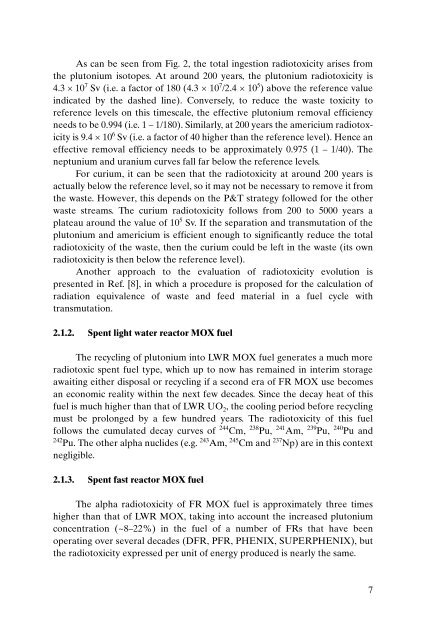TRS435_web
TRS435_web
TRS435_web
Create successful ePaper yourself
Turn your PDF publications into a flip-book with our unique Google optimized e-Paper software.
As can be seen from Fig. 2, the total ingestion radiotoxicity arises from<br />
the plutonium isotopes. At around 200 years, the plutonium radiotoxicity is<br />
4.3 × 10 7 Sv (i.e. a factor of 180 (4.3 × 10 7 /2.4 × 10 5 ) above the reference value<br />
indicated by the dashed line). Conversely, to reduce the waste toxicity to<br />
reference levels on this timescale, the effective plutonium removal efficiency<br />
needs to be 0.994 (i.e. 1 – 1/180). Similarly, at 200 years the americium radiotoxicity<br />
is 9.4 × 10 6 Sv (i.e. a factor of 40 higher than the reference level). Hence an<br />
effective removal efficiency needs to be approximately 0.975 (1 – 1/40). The<br />
neptunium and uranium curves fall far below the reference levels.<br />
For curium, it can be seen that the radiotoxicity at around 200 years is<br />
actually below the reference level, so it may not be necessary to remove it from<br />
the waste. However, this depends on the P&T strategy followed for the other<br />
waste streams. The curium radiotoxicity follows from 200 to 5000 years a<br />
plateau around the value of 10 5 Sv. If the separation and transmutation of the<br />
plutonium and americium is efficient enough to significantly reduce the total<br />
radiotoxicity of the waste, then the curium could be left in the waste (its own<br />
radiotoxicity is then below the reference level).<br />
Another approach to the evaluation of radiotoxicity evolution is<br />
presented in Ref. [8], in which a procedure is proposed for the calculation of<br />
radiation equivalence of waste and feed material in a fuel cycle with<br />
transmutation.<br />
2.1.2. Spent light water reactor MOX fuel<br />
The recycling of plutonium into LWR MOX fuel generates a much more<br />
radiotoxic spent fuel type, which up to now has remained in interim storage<br />
awaiting either disposal or recycling if a second era of FR MOX use becomes<br />
an economic reality within the next few decades. Since the decay heat of this<br />
fuel is much higher than that of LWR UO 2 , the cooling period before recycling<br />
must be prolonged by a few hundred years. The radiotoxicity of this fuel<br />
follows the cumulated decay curves of 244 Cm, 238 Pu, 241 Am, 239 Pu, 240 Pu and<br />
242 Pu. The other alpha nuclides (e.g. 243 Am, 245 Cm and 237 Np) are in this context<br />
negligible.<br />
2.1.3. Spent fast reactor MOX fuel<br />
The alpha radiotoxicity of FR MOX fuel is approximately three times<br />
higher than that of LWR MOX, taking into account the increased plutonium<br />
concentration (~8–22%) in the fuel of a number of FRs that have been<br />
operating over several decades (DFR, PFR, PHENIX, SUPERPHENIX), but<br />
the radiotoxicity expressed per unit of energy produced is nearly the same.<br />
7


